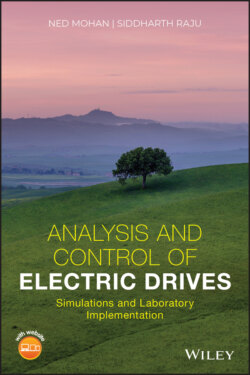Читать книгу Analysis and Control of Electric Drives - Ned Mohan - Страница 66
Gears
Оглавление1 2‐6 In the gear system shown in Fig. 2-14, the gear ratio nL/nM = 3 where n equals the number of teeth in gear. The load and motor inertia are JL = 10 kg ⋅ m2 and JM = 1.2 kg ⋅ m2. Damping and the load‐torque TL can be neglected. For the load‐speed profile shown in Fig. 2-1b, draw the profile of the electromagnetic torque Tem required from the motor as a function of time.
2 2‐7 In the system of Problem 2-6, assume a triangular speed profile of the load with equal acceleration and deceleration rates (starting and ending at zero speed). Assuming a coupling efficiency of 100%, calculate the time needed to rotate the load by an angle of 30o if the magnitude of the electromagnetic torque (positive or negative) from the motor is 500 Nm.
3 2‐8 The vehicle in 2-8Example is powered by motors that have a maximum speed of 5000 rpm. Each motor is coupled to the wheel using a gear mechanism. (a) Calculate the required gear ratio if the vehicle’s maximum speed is 150 km/h, and (b) calculate the torque required from each motor at the maximum speed.
4 2‐9 Consider the system shown in Fig. 2-14. For JM = 40 g ⋅ cm2 and JL = 60 g ⋅ cm2, what is the optimum gear ratio to minimize the torque required from the motor for a given load‐speed profile? Neglect damping and external load torque.
